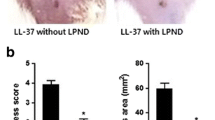Abstract
Phototherapy with 311-nm narrowband-UVB (NBUVB) is an effective adjuvant treatment modality for atopic dermatitis (AD). In this study, we evaluated the therapeutic effect of the newly developed gain-switched 311-nm Ti:Sapphire laser device using a NC/Nga mouse AD model. A total number of 50 mice were used in this study. Atopic dermatitis (AD) was induced in mice by exposure to Dermatophagoides farina. These, NC/Nga mice were then treated with conventional 311-nm NBUVB or the newly developed gain-switched 311-nm Ti:Sapphire laser. The clinical features, dermatitis severity scores, and scratching behavior were assessed. In addition, serologic analyses including inflammatory cytokines and histological analyses were performed. Gain-switched 311-nm Ti:Sapphire laser improved the AD-like skin lesions, severity, and symptoms of AD in the NC/Nga mouse model. This new laser also modulated the immune response found in the AD model, including hyper-IgE, upregulated Th2 cytokines, and the Th2-mediated allergic inflammatory reaction. Gain-switched 311-nm Ti:Sapphire laser shows therapeutic promise via an immune-modulation mechanism in an AD mouse model. These data suggest that gain-switched 311-nm Ti:Sapphire laser may be useful as a targeted phototherapy modality for AD.





Similar content being viewed by others
References
De Benedetto A, Agnihothri R, McGirt LY, Bankova LG, Beck LA (2009) Atopic dermatitis: a disease caused by innate immune defects? J Invest Dermatol 129:14–30
Eichenfield LF, Tom WL, Berger TG, Krol A, Paller AS, Schwarzenberger K et al (2014) Guidelines of care for the management of atopic dermatitis: section 2. Management and treatment of atopic dermatitis with topical therapies. J Am Acad Dermatol 71:116–132
Ring J, Alomar A, Bieber T, Deleuran M, Fink-Wagner A, Gelmetti C et al (2012) Guidelines for treatment of atopic eczema (atopic dermatitis) part I. J Eur Acad Dermatol Venereol 26:1045–1060
Denby KS, Beck LA (2012) Update on systemic therapies for atopic dermatitis. Curr Opin Allergy Clin Immunol 12:421–426
Ring J, Alomar A, Bieber T, Deleuran M, Fink-Wagner A, Gelmetti C et al (2012) Guidelines for treatment of atopic eczema (atopic dermatitis) Part II. J Eur Acad Dermatol Venereol 26:1176–1193
Jekler J, Larkö O (1988) UVB phototherapy of atopic dermatitis. Br J Dermatol 119:697–705
Der-Petrossian M, Seeber A, Hönigsmann H, Tanew A (2000) Half-side comparison study on the efficacy of 8-methoxypsoralen bath-PUVA versus narrow-band ultraviolet B phototherapy in patients with severe chronic atopic dermatitis. Br J Dermatol 142:39–43
Reynolds NJ, Franklin V, Gray JC, Diffey BL, Farr PM (2001) Narrow-band ultraviolet B and broad-band ultraviolet A phototherapy in adult atopic eczema: a randomised controlled trial. Lancet 357:2012–2016
Legat FJ, Hofer A, Brabek E, Quehenberger F, Kerl H, Wolf P (2003) Narrowband UV-B vs medium-dose UV-A1 phototherapy in chronic atopic dermatitis. Arch Dermatol 139:223–224
Anderson TF, Waldinger TP, Voorhees JJ (1984) UV-B phototherapy. An overview. Arch Dermatol 120:1502–1507
Baltás E, Csoma Z, Bodai L, Ignácz F, Dobozy A, Kemény L (2006) Treatment of atopic dermatitis with the xenon chloride excimer laser. J Eur Acad Dermatol Venereol 20:657–660
Tarasov A, Chu H (2015) Solid-state laser wavelength selection and tuning by fused-silica-transmission gratings with subwavelength deep-surface relief. Opt Lett 40:3572–3575
Matsuoka H, Maki N, Yoshida S, Arai M, Wang J, Oikawa Y et al (2003) A mouse model of the atopic eczema/dermatitis syndrome by repeated application of a crude extract of house-dust mite Dermatophagoides farinae. Allergy 58:139–145
Inoue T, Sugimoto M, Sakurai T, Saito R, Futaki N, Hashimoto Y et al (2007) Modulation of scratching behavior by silencing an endogenous cyclooxygenase-1 gene in the skin through the administration of siRNA. J Gene Med 9:994–1001
Kwon TR, Mun SK, Oh CT, Hong H, Choi YS, Kim BJ, Kim BJ (2014) Therapeutic effects of full spectrum light on the development of atopic dermatitis-like lesions in NC/Nga mice. Photochem Photobiol 90:1160–1169
Simon JC, Pfieger D, Schöpf E (2000) Recent advances in phototherapy. Eur J Dermatol 10:642–645
Tarasov A, Chu H (2015) Solid-state laser wavelength selection and tuning by fused-silica-transmission gratings with subwavelength deep-surface relief. Opt Lett 40(15):3572–3575
Author information
Authors and Affiliations
Corresponding author
Ethics declarations
Funding sources
None
Conflict of interest
None declared
Additional information
Sun Young Choi and Chang Taek OH contributed equally to this work.
Rights and permissions
About this article
Cite this article
Choi, S.Y., OH, C.T., Kwon, TR. et al. Gain-switched 311-nm Ti:Sapphire laser might be a potential treatment modality for atopic dermatitis. Lasers Med Sci 31, 1437–1445 (2016). https://doi.org/10.1007/s10103-016-2006-8
Received:
Accepted:
Published:
Issue Date:
DOI: https://doi.org/10.1007/s10103-016-2006-8




